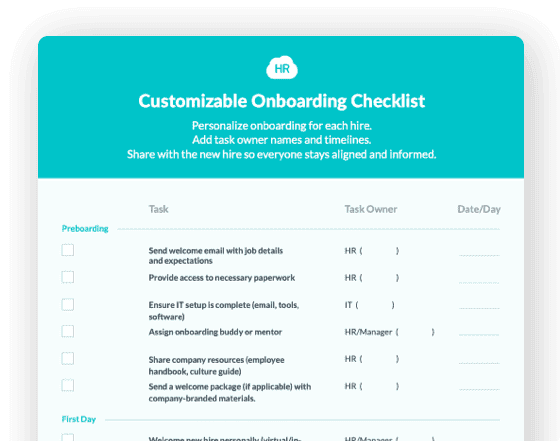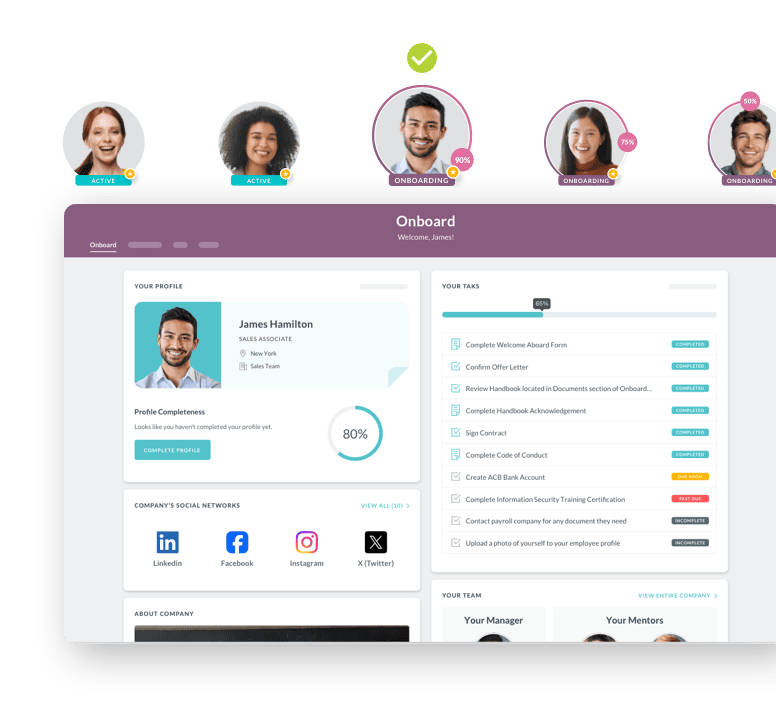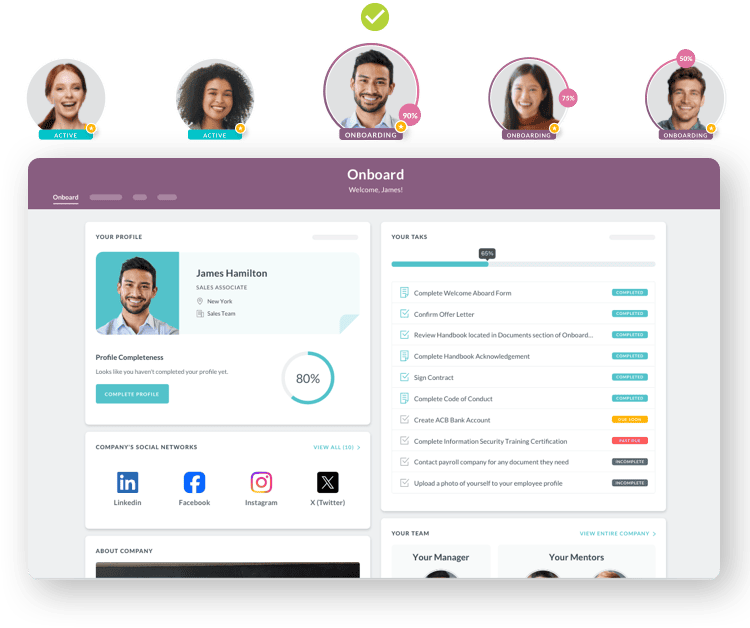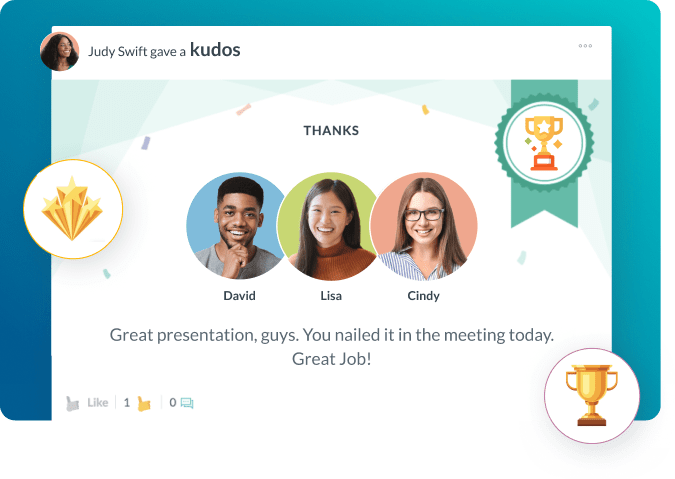HRIS Systems
- What Makes an HRIS Essential for Modern Businesses
- Comparing HRIS Deployment Models
- Proven Strategies for HRIS Success
- Common HRIS Implementation Mistakes to Avoid
- How Different Industries Use HRIS Technology
- Your Step-by-Step HRIS Implementation Roadmap
- The Future of HRIS Technology and What It Means for You

 Cut onboarding time
by 60%—here's the
Ultimate Checklist
that helped do it.
Cut onboarding time
by 60%—here's the
Ultimate Checklist
that helped do it.

HRIS Systems: Your Complete Guide to Human Resource Information Systems
Every business runs on people. Managing those people effectively can make the difference between thriving and merely surviving. A Human Resource Information System, or HRIS, is the digital foundation that helps organizations store, manage, and use employee data to make better decisions. Think of it as the central hub where all your workforce information lives and works for you.
An HRIS is software that collects and organizes employee information in one secure place. It handles everything from basic contact details and job titles to complex workflows like payroll processing and compliance tracking. More than just a database, modern HRIS platforms transform how HR teams operate by automating manual tasks and providing real-time insights into your workforce.
The business case for HRIS implementation is straightforward. Manual HR processes eat up valuable time, increase error rates, and make strategic planning nearly impossible. When you implement an HRIS, you free your HR team to focus on what matters most: building a culture where people can do their best work. Research from SHRM shows that organizations using HRIS technology report significant improvements in efficiency and data accuracy.
For growing companies, the question isn't whether to implement an HRIS. It's which system will best support your unique needs and growth trajectory.
What Makes an HRIS Essential for Modern Businesses
Before diving into features and implementation, let's clarify what an HRIS actually delivers to your organization. These systems go far beyond simple record keeping.
An effective HRIS serves multiple critical functions across your business. It centralizes employee data so you can access accurate information instantly. It automates routine tasks like time tracking and benefits enrollment, reducing administrative burden. The system ensures compliance with labor laws and regulations by maintaining proper documentation. It generates reports and analytics that inform strategic workforce decisions. Most importantly, it improves the employee experience by providing self-service tools and streamlined processes.
The distinction between HRIS, HRMS, and HCM often confuses business leaders. Understanding these differences helps you select the right solution. An HRIS focuses on core HR functions and data management. An HRMS expands this to include talent management capabilities. HCM systems encompass the full employee lifecycle with advanced analytics and strategic planning tools. For most mid-market companies, a robust HRIS with scalable features provides the best starting point.
Comparing HRIS Deployment Models
|
Deployment Type |
Best For |
Key Benefits |
Considerations |
|
Cloud-Based |
Growing companies, remote teams |
Lower upfront costs, automatic updates, accessible anywhere |
Requires reliable internet, ongoing subscription fees |
|
On-Premise |
Large enterprises with strict data requirements |
Complete control over data, one-time licensing |
Higher initial investment, requires IT resources |
|
Hybrid |
Organizations with mixed needs |
Flexibility to customize, balanced control |
More complex to manage, requires integration planning |
Proven Strategies for HRIS Success
Implementing an HRIS effectively requires more than choosing good software. You need a thoughtful approach that considers your people, processes, and business goals.
Start by defining clear objectives for what you want your HRIS to accomplish. Are you focused on reducing administrative time, improving data accuracy, or enabling better workforce planning? Your goals will guide every decision you make. Next, involve stakeholders from across your organization early in the process. HR professionals, IT teams, department managers, and even employees should provide input. Their perspectives ensure you select a system that actually works for how people do their jobs.
Choose a vendor that offers strong implementation support and ongoing customer service. According to SHRM research on HRIS selection, vendor support ranks among the top factors determining implementation success. Plan for comprehensive training that goes beyond basic system navigation. Your team needs to understand not just how to use the software, but how it connects to their daily work and strategic goals.
Take a phased approach to implementation rather than trying to activate everything at once. Start with core functions like employee records and payroll integration, then gradually add modules for time tracking, performance management, and advanced analytics. This approach reduces overwhelm and allows your team to build confidence with the system.


Common HRIS Implementation Mistakes to Avoid
Even well-intentioned HRIS projects can run into trouble. Understanding these pitfalls helps you navigate around them.
The biggest mistake is treating HRIS adoption as purely a technology project. Research shows that 68% of organizations fail to achieve expected adoption rates because they focus on software features rather than user needs and behavior change. Your HRIS implementation is fundamentally a people initiative that happens to use technology.
Many companies underestimate the importance of data quality before migration. Migrating poor data into your new system creates problems that compound over time. Take the time to clean, standardize, and validate your employee information before you move it. Another common error is selecting a system based primarily on features rather than usability. A platform loaded with capabilities means nothing if your team finds it confusing or time-consuming to use.
Overlooking change management is another frequent mistake. People resist new systems when they don't understand the benefits or feel unprepared to use them. Build a change management strategy that includes clear communication, hands-on training, and ongoing support. Don't ignore integration requirements with your existing technology stack. Your HRIS needs to work seamlessly with payroll, applicant tracking, and other business systems.
How Different Industries Use HRIS Technology
HRIS systems adapt to serve the specific needs of different sectors. These examples show how versatile these platforms can be.
Healthcare organizations face unique workforce challenges. They manage complex licensing requirements, track continuing education credits, ensure compliance with HIPAA and other regulations, and coordinate schedules across multiple locations. Healthcare-focused HRIS solutions help providers maintain certification databases, automate credential verification, and generate compliance reports. For a multi-location healthcare system, this might mean tracking nursing licenses across different states, managing shift schedules for 24/7 operations, and documenting mandatory training completion.
Manufacturing companies use HRIS platforms to manage hourly workforces, track safety training and certifications, process time and attendance for shift workers, and maintain union contract compliance. A manufacturing operation might use its HRIS to automatically assign safety training based on job roles, track equipment certifications, and generate reports for regulatory inspections.
Technology companies leverage HRIS capabilities for rapid scaling, managing remote and distributed teams, tracking project-based work, and analyzing talent acquisition metrics. A growing tech startup might use its HRIS to streamline remote onboarding workflows, manage equity compensation, and identify skill gaps as they scale.
Your Step-by-Step HRIS Implementation Roadmap
Successful HRIS implementation follows a clear sequence. This roadmap keeps your project on track and delivers results.
Phase one focuses on assessment and planning. Conduct a thorough needs analysis with stakeholders from HR, IT, finance, and operations. Document your current processes, pain points, and desired outcomes. Define success metrics that align with business objectives. Research potential vendors and narrow your list to three to five candidates that match your requirements and budget.
Phase two involves vendor selection and contract negotiation. Request detailed demonstrations focused on your specific use cases. Check references from companies similar to yours in size and industry. Review service level agreements, data security protocols, and implementation support carefully. Negotiate contract terms that protect your interests and provide flexibility for future growth.
Phase three covers data preparation and system configuration. Clean and standardize your employee data before migration. Work with your vendor to configure the system to match your organizational structure, business rules, and workflows. Establish security roles and permissions based on job functions. Build integrations with your payroll system, applicant tracking software, and other critical tools.
Phase four brings training and deployment. Develop role-based training programs for different user groups. Create quick reference guides and video tutorials for common tasks. Conduct pilot testing with a small group before full rollout. Enable employee self-service features that reduce the burden on HR staff. Launch with strong communication about benefits and available support.
Phase five ensures ongoing optimization. Monitor adoption rates and gather user feedback regularly. Address issues quickly and make adjustments based on real usage patterns. Expand functionality gradually as users build confidence. Review your HRIS performance against initial success metrics and adjust strategies as needed.
The Future of HRIS Technology and What It Means for You
HRIS platforms are evolving rapidly, driven by artificial intelligence, automation, and changing workforce expectations. Understanding these trends helps you future-proof your HR technology strategy.
Artificial intelligence is transforming HRIS capabilities. According to industry analysis, AI-powered systems now offer predictive analytics for turnover risk, automated candidate screening, personalized learning recommendations, and intelligent chatbots for employee questions. These tools don't replace human judgment. They enhance it by handling routine decisions and surfacing insights that would take hours to uncover manually.
Mobile-first experiences are becoming standard rather than optional. Employees expect to manage time off requests, update personal information, access pay stubs, and complete training from their phones. HRIS vendors are redesigning interfaces with mobile users as the primary consideration.
Integration ecosystems continue to expand. Modern HRIS platforms function as hubs that connect with dozens of specialized tools for recruiting, learning management, employee engagement, and workforce planning. This composable approach lets you build a technology stack tailored to your needs without forcing everything into a single monolithic system.
The emphasis is shifting from data collection to data intelligence. Simply storing employee information is table stakes. Forward-thinking organizations use their HRIS data to predict workforce needs, identify high-potential employees, optimize compensation strategies, and measure the ROI of HR initiatives. Your HRIS becomes a strategic asset that informs business decisions across the organization.
Prepare for these changes by choosing systems with open APIs and strong integration capabilities. Invest in building data literacy within your HR team. Stay informed about emerging technologies but avoid chasing trends without clear business cases. Focus on maximizing the value of your current HRIS capabilities while keeping an eye on innovations that could provide genuine competitive advantage.
The most successful organizations view their HRIS not as a project with an end date, but as an evolving platform that grows with their business. Understanding the glossary of employee onboarding and related HR terms helps you make informed decisions as you build out your HR technology ecosystem. When implemented thoughtfully with attention to both technology and people, an HRIS transforms HR from an administrative function into a strategic partner that drives business success.
 Discover how our HR solutions streamline onboarding, boost employee engagement, and simplify HR management
Discover how our HR solutions streamline onboarding, boost employee engagement, and simplify HR management
Keep Reading
From Manual to Automated: A Complete Guide to Digitizing Employee Onboarding for Large Organizations
Sarah Chen, Director of HR at a 7,000-employee healthcare organization, starts her Monday
Enterprise HR Software in 2025: Why Traditional Enterprise Platforms Fall Short and What Actually Works
Traditional enterprise human resources software systems promise comprehensive solutions
AI in Onboarding: Complete Guide for 2026
You’ve probably been hearing this multiple times a day — AI is transforming HR. But
Ready to streamline your onboarding process?
Book a demo today and see how HR Cloud can help you create an exceptional experience for your new employees.







